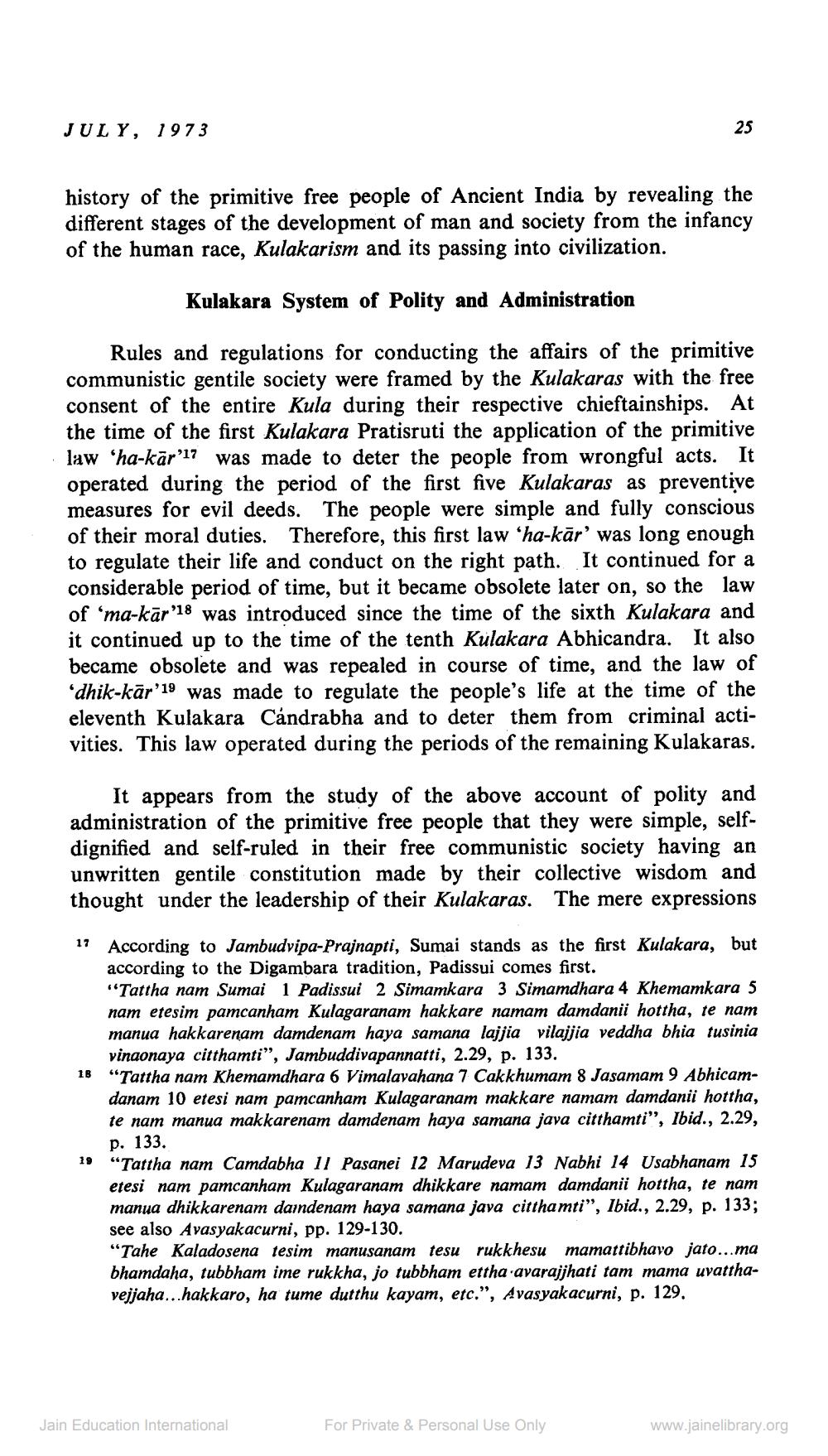________________
JULY, 1973
history of the primitive free people of Ancient India by revealing the different stages of the development of man and society from the infancy of the human race, Kulakarism and its passing into civilization.
Kulakara System of Polity and Administration
Rules and regulations for conducting the affairs of the primitive communistic gentile society were framed by the Kulakaras with the free consent of the entire Kula during their respective chieftainships. At the time of the first Kulakara Pratisruti the application of the primitive law 'ha-kar'17 was made to deter the people from wrongful acts. It operated during the period of the first five Kulakaras as preventive measures for evil deeds. The people were simple and fully conscious of their moral duties. Therefore, this first law 'ha-kar' was long enough to regulate their life and conduct on the right path. It continued for a considerable period of time, but it became obsolete later on, so the law of 'ma-kar'18 was introduced since the time of the sixth Kulakara and it continued up to the time of the tenth Kulakara Abhicandra. It also became obsolete and was repealed in course of time, and the law of 'dhik-kar'19 was made to regulate the people's life at the time of the eleventh Kulakara Cándrabha and to deter them from criminal activities. This law operated during the periods of the remaining Kulakaras.
It appears from the study of the above account of polity and administration of the primitive free people that they were simple, selfdignified and self-ruled in their free communistic society having an unwritten gentile constitution made by their collective wisdom and thought under the leadership of their Kulakaras. The mere expressions
25
17 According to Jambudvipa-Prajnapti, Sumai stands as the first Kulakara, but according to the Digambara tradition, Padissui comes first.
"Tattha nam Sumai 1 Padissui 2 Simamkara 3 Simamdhara 4 Khemamkara 5 nam etesim pamcanham Kulagaranam hakkare namam damdanii hottha, te nam manua hakkarenam damdenam haya samana lajjia vilajjia veddha bhia tusinia vinaonaya citthamti", Jambuddivapannatti, 2.29, p. 133.
18 "Tattha nam Khemamdhara 6 Vimalavahana 7 Cakkhumam 8 Jasamam 9 Abhicamdanam 10 etesi nam pamcanham Kulagaranam makkare namam damdanii hottha, te nam manua makkarenam damdenam haya samana java citthamti", Ibid., 2.29, p. 133.
19
"Tattha nam Camdabha 11 Pasanei 12 Marudeva 13 Nabhi 14 Usabhanam 15 etesi nam pamcanham Kulagaranam dhikkare namam damdanii hottha, te nam manua dhikkarenam damndenam haya samana java citthamti", Ibid., 2.29, p. 133; see also Avasyakacurni, pp. 129-130.
"Tahe Kaladosena tesim manusanam tesu rukkhesu mamattibhavo jato...ma bhamdaha, tubbham ime rukkha, jo tubbham ettha avarajjhati tam mama uvatthavejjaha...hakkaro, ha tume dutthu kayam, etc.", Avasyakacurni, p. 129.
Jain Education International
For Private & Personal Use Only
www.jainelibrary.org




